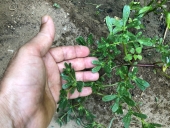
 21
21




 7
7




Om is where the heart is.
 5
5




I do Celtic, fantasy, folk and shanty singing at Renaissance faires, fantasy festivals, pirate campouts, and other events in OR and WA, USA.
RionaTheSinger on youtube
 1
1




Invasive plants are Earth's way of insisting we notice her medicines. Stephen Herrod Buhner
Everyone learns what works by learning what doesn't work. Stephen Herrod Buhner
 12
12




 9
9




Pete Podurgiel wrote: one item you might consider adding to your list is sunflower seeds. I've had mixed results with them though, mostly to do with the seed husks clinging to the sprouts (along with some soil) and made for a difficult harvest.
Riona Abhainn wrote:How much does it scale up your electric bill?
 But I calculated it is about $1 dollar a day depending on electricity rate to run the 8x42w LED lights for 16 hours a day. So even one big salad a week would break even which is more than doable.
But I calculated it is about $1 dollar a day depending on electricity rate to run the 8x42w LED lights for 16 hours a day. So even one big salad a week would break even which is more than doable.
James MacKenzie wrote:If you grow your peppers in pots you can bring them in and overwinter them quite successfully.
cheers!
Anne Miller wrote: You mentioned pea, did you get any peas to produce?
 5
5




"The genius of American farm experts is very well demonstrated here: they can take a solution and divide it neatly into two problems." -Wendell Berry
 6
6




James MacKenzie wrote:If you grow your peppers in pots you can bring them in and overwinter them quite successfully...
...
cheers!
A build too cool to miss:Mike's GreenhouseA great example:Joseph's Garden
All the soil info you'll ever need:
Redhawk's excellent soil-building series






 4
4




- Tim's Homestead Journal - Purchase a copy of Building a Better World in Your Backyard - Purchase 6 Decks of Permaculture Cards -
- Purchase 12x Decks of Permaculture Cards - Purchase a copy of the SKIP Book - Purchase 12x copies of Building a Better World in your Backyard
 8
8




Zone 6, 45 inches precipitation, hard clay soil





 3
3




Working toward a permaculture-strong retirement near sunny Sperling.
 3
3




The inspiration for all innovation can be traced back to the land/nature.
 2
2




 9
9




Donna Lynn wrote: Note re: interplanting greens with the peas: I would try to design shelves/trays that I could lift or lower relative to the fixed grow light, and have a narrower planter for the peas, and another narrower one for the greens that can be moved individually. They could still take up the same space more or less, but each stay the appropriate distance from the light source. I realize this would not be quite as efficient as interplanting, and would not promote soil microorganism diversity, but overall I think it might suit small scale indoor produce growers better than trying to move the lights up and down and not being able to accommodate all the plants' heights. That's just a thought, not sure how well it would translate into real life!
Visit Redhawk's soil series: https://permies.com/wiki/redhawk-soil
How permies.com works: https://permies.com/wiki/34193/permies-works-links-threads











 2
2




Jay Angler wrote:
1. Yes, the lights need to be *very* close to the growing mass of the plant. There's physics that will tell you how light strength drops with distance... but not in my brain today.
Working toward a permaculture-strong retirement near sunny Sperling.
 3
3





|
I need a new interior decorator. This tiny ad just painted every room in my house purple.
The new gardening playing cards kickstarter is now live!
https://www.kickstarter.com/projects/paulwheaton/garden-cards
|






